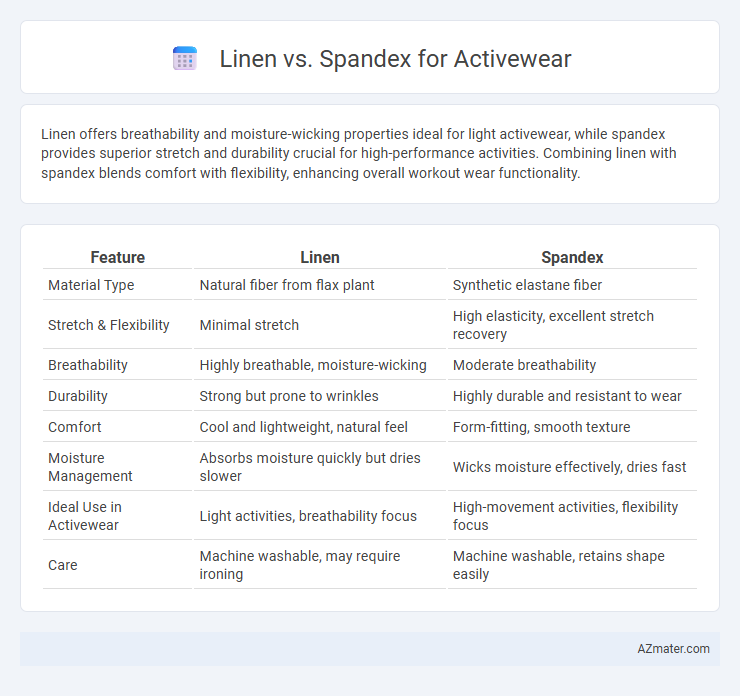Linen offers breathability and moisture-wicking properties ideal for light activewear, while spandex provides superior stretch and durability crucial for high-performance activities. Combining linen with spandex blends comfort with flexibility, enhancing overall workout wear functionality.
Table of Comparison
| Feature | Linen | Spandex |
|---|---|---|
| Material Type | Natural fiber from flax plant | Synthetic elastane fiber |
| Stretch & Flexibility | Minimal stretch | High elasticity, excellent stretch recovery |
| Breathability | Highly breathable, moisture-wicking | Moderate breathability |
| Durability | Strong but prone to wrinkles | Highly durable and resistant to wear |
| Comfort | Cool and lightweight, natural feel | Form-fitting, smooth texture |
| Moisture Management | Absorbs moisture quickly but dries slower | Wicks moisture effectively, dries fast |
| Ideal Use in Activewear | Light activities, breathability focus | High-movement activities, flexibility focus |
| Care | Machine washable, may require ironing | Machine washable, retains shape easily |
Introduction: Comparing Linen and Spandex for Activewear
Linen and spandex offer distinct advantages for activewear, with linen being a natural fiber known for breathability and moisture-wicking properties, while spandex provides superior elasticity and shape retention. Linen's lightweight texture enhances comfort during low-impact activities, whereas spandex delivers flexibility and durability for high-intensity workouts. Choosing between linen and spandex depends on the specific performance needs, such as temperature regulation or stretchability, required in activewear design.
Fabric Composition and Properties
Linen is a natural fiber known for its breathability, moisture-wicking, and durability, making it ideal for lightweight, breathable activewear, especially in warm climates. Spandex, a synthetic fiber composed of polyurethane, offers exceptional elasticity and shape retention, providing superior stretch and comfort for dynamic movements during workouts. Blending linen with spandex enhances activewear by combining natural airflow with flexible support and improved fit.
Moisture-Wicking Capabilities
Linen excels in moisture-wicking due to its natural fiber structure, which absorbs and releases sweat quickly, keeping the skin dry and cool during workouts. Spandex, while highly stretchable and form-fitting, lacks inherent moisture-wicking properties and is often blended with other fabrics to enhance breathability and sweat management. Activewear combining linen with spandex offers a balance of moisture control and flexibility, optimizing comfort and performance.
Breathability and Comfort
Linen offers superior breathability for activewear due to its natural fibers, which allow excellent airflow and moisture-wicking, keeping the skin cool and dry during workouts. Spandex, known for its exceptional stretch and flexibility, enhances comfort by providing a snug, supportive fit but lacks the same level of breathability as linen. Combining linen's airflow properties with spandex's elasticity can create activewear that balances comfort and performance effectively.
Durability and Stretch
Linen offers natural durability and breathability but lacks significant stretch, making it less flexible for dynamic movements in activewear. Spandex is highly elastic and retains its shape under strain, providing superior stretch and support essential for activewear performance. Combining linen with a small percentage of spandex enhances durability while allowing freedom of movement and moisture-wicking properties.
Style and Fit Adaptability
Linen offers a breathable, lightweight fabric ideal for loose-fitting activewear, providing natural moisture-wicking and a relaxed style that enhances comfort during low-impact activities. Spandex, known for its exceptional elasticity, delivers a snug, form-fitting silhouette that adapts to body movements, making it perfect for high-intensity workouts requiring maximum flexibility. Combining linen's breathable texture with spandex's stretch creates versatile activewear that balances style, durability, and adaptive fit for diverse exercise routines.
Maintenance and Care Requirements
Linen activewear requires gentle washing in cold water to prevent shrinkage and should be air-dried to maintain its breathable texture, while spandex demands low-temperature washing to preserve elasticity and avoid fabric damage. Fabric softeners should be avoided with spandex as they can degrade the stretch fibers, whereas linen benefits from occasional ironing to smooth wrinkles without compromising its durability. Both materials perform best when stored properly to maintain shape, with linen thriving in a dry, ventilated environment and spandex retaining flexibility when kept away from heat and direct sunlight.
Sustainable and Eco-Friendly Factors
Linen, derived from flax plants, is a highly sustainable fabric due to its low water and pesticide requirements, natural biodegradability, and renewable crop source, making it an eco-friendly choice for activewear. Spandex, however, is a synthetic fiber produced from petrochemicals, contributing to environmental pollution and non-biodegradability, which challenges sustainability efforts despite its elasticity benefits. Choosing linen-based activewear supports reduced environmental impact through biodegradable materials and low resource use, aligning well with eco-conscious and sustainable fashion goals.
Cost and Accessibility
Linen activewear tends to be more expensive due to its natural fiber production and limited availability, making it less accessible for budget-conscious consumers. Spandex, known for its synthetic elasticity, offers a more affordable and widely accessible option across various retail outlets and price ranges. Consumers seeking cost-effective activewear with stretch and durability often prefer spandex blends over pure linen fabrics.
Best Use Cases for Linen vs Spandex Activewear
Linen activewear excels in breathability and moisture-wicking, making it ideal for hot weather workouts like yoga, pilates, and light aerobic activities where cooling and comfort are priorities. Spandex activewear offers superior stretch and shape retention, perfect for high-intensity training, running, and activities requiring maximum flexibility and support. Choosing linen suits low-impact, casual exercise, while spandex supports rigorous, performance-driven workouts.

Infographic: Linen vs Spandex for Activewear
 azmater.com
azmater.com